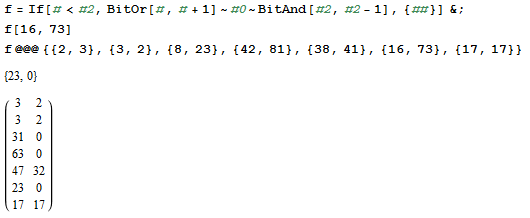20
2
Did you know that a small number can borrow bits from a larger number? Here's an example. Let's say our two numbers 5 and 14. First, write them out in binary:
5 14
000101 001110
First we take the smallest on bit away from the larger number, and we give it to the smallest off bit on the other number. So
This bit turns off
|
v
000101 001110
^
|
This bit turns on
Now we have
000111 001100
and our numbers are 7 and 12. The first number is still smaller, so we continue.
000111 001100
001111 001000
Now we have 15 and 8, so we can stop. We'll call this set of operations "bit-borrowing" two numbers. Let's do another example. 20 and 61.
20 61
010100 111101
010101 111100
010111 111000
111111 100000
63 32
So our end result is 32, 63. Let's do one more. 31, and 12. 31 is already bigger than 12, so there's nothing to do! Bit-borrowing 31 and 12 gives 31 and 12, no change.
The challenge
Your challenge is to write a program or function that takes two numbers and bit-borrows them. The two numbers will always positive integers. Your input and output can be in any reasonable format.
Test IO:
Input: 2, 3
Output: 3, 2
Input: 3, 2
Output: 3, 2
Input: 8, 23
Output: 31, 0
Input: 42, 81
Output: 63, 0
Input: 38, 41
Output: 47, 32
Input: 16, 73
Output: 23, 0
Input: 17, 17
Output: 17, 17
Standard loopholes apply, and shortest answer in bytes wins!

Nice answer! Sorry to change the challenge after you've posted an answer, but I've simplified the challenge a little bit. (you don't need to iterate over the list any more). That should let you shorten it a little bit more. – James – 2016-06-17T07:35:05.210
@DrGreenEggsandIronMan J is actually applying the function element-wise between the two arrays without any explicit ranking, which is nice. Unless there's another trick, it will probably stay the same. – miles – 2016-06-17T08:16:39.557